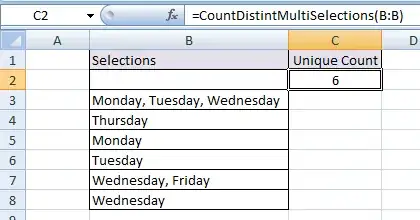The simplest solution would be to use a UDF. (I'm not even sure it's possible with a standard formula.)
With a worksheet set up like this:

Copy-paste the following code to a standard module:
'============================================================================================
' Module : <any standard module>
' Version : 0.1.1
' Part : 1 of 1
' References : (Optional) Microsoft Scripting Runtime [Scripting]
' Source : https://superuser.com/a/1332369/763880
'============================================================================================
Option Explicit
Public Function CountDistintMultiSelections _
( _
count_array As Range _
) _
As Long
Dim dictSelections As Object '##Early Bound## As Scripting.Dictionary
Set dictSelections = CreateObject("Scripting.Dictionary") '##Early Bound## = New Dictionary
Dim celCell As Range
For Each celCell In Intersect(count_array, count_array.Parent.UsedRange)
Dim varSelections As Variant
varSelections = Split(celCell.Value2, ", ")
Dim varSelection As Variant
For Each varSelection In varSelections
If dictSelections.Exists(varSelection) Then
dictSelections(varSelection) = dictSelections(varSelection) + 1
Else
dictSelections.Add varSelection, 1
End If
Next varSelection
Next celCell
CountDistintMultiSelections = dictSelections.Count
End Function
Enter the following formula in C2:
=CountDistintMultiSelections(B:B)
Explanation:
The code uses the Split() function to separate out the individual selections in each cell, and a dictionary to count the unique selections.
Notes:
To install the UDF, follow these steps:
- Press Alt+F11
- Select the menu item
Insert → Module
- Paste the code in the main window
